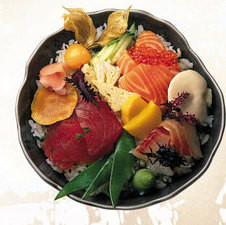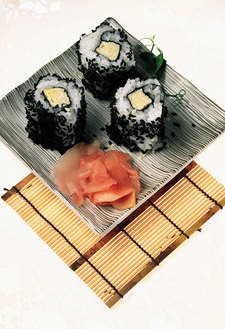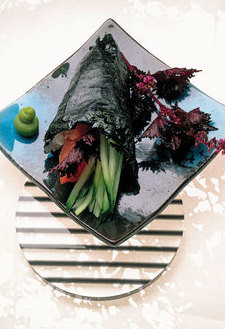 How to Make Sushi at HomeIn traditional Japaneseресторанах повара допускают к приготовлению суши лишь после десяти лет ученичества. Неслучайно буддийская пословица гласит: «Чтобы пройти тысячу шагов к просветлению, нужна тысяча лет. И еще столько же – чтобы сделать последний шаг». Однако это вовсе не повод отказаться от попытки приготовить суши и роллы самостоятельно. Но прежде, чем переходить к импровизации (японская кухня располагает к ней как никакая другая, и вам наверняка захочется изобретать собственные сочетания и формы), необходимо освоить основные правила, запастись подходящим инвентарем и продуктами.ИнвентарьБамбуковый коврик (с его помощью вы будете скручивать роллы), палочки для еды и неглубокие пиалы, в которых удобно смешивать соевый соус с острым васаби, можно сегодня приобрести в любом супермаркете.ПродуктыГлавное в суши – это качество продуктов. Поэтому не стоит пытаться на них сэкономить: и рис, и овощи, и рыба, и нори – все должно быть первоклассным. Рис лучше купить специальный японский «для суши» (его можно заменить и мелким итальянским арборио, и даже недорогим круглозерным краснодарским, но это неизбежно отразится на вкусе). Вам понадобятся: рисовый уксус, японский соевый соус, острый японский хрен васаби (лучше приобрести не готовую пасту, а порошок и приготовить приправу самостоятельно – для этого чайную ложку сухого продукта нужно смешать с чайной ложкой холодной воды и дать настояться 10–15 минут), листки нори – подсушенных морских водорослей, гладкие с одной стороны и шершавые (чтобы лучше держался рис) с другой, а также розоватый маринованный имбирь – гари. Если вы будете использовать авокадо, помните, что этот овощ легко окисляется: чтобы предохранить его от потемнения, сбрызните ломтики лимонным соком. Что касается рыбы, то она обязательно должна быть охлажденной, а не размороженной и очень свежей. Если вы не можете позволить себе дорогую рыбу, выберите более скромный сорт (скажем, замените тунца лососем), однако в том, что касается свежести, компромиссов быть не должно. Секреты рисаПеред нужно тщательно промыть и залить водой в соотношении один к полутора. После того как вода закипит, накройте кастрюлю крышкой и варите, не перемешивая, в течение 22–23 минут, постепенно увеличивая огонь от малого до среднего. Когда рис станет мягким и впитает всю воду (при необходимости можно добавить еще немного кипятка), снимите с огня, перемешайте деревянной лопаточкой, добавьте суши-уксус и еще раз перемешайте. Суши-уксус продается готовым, однако его несложно приготовить самостоятельно: для этого шесть столовых ложек рисового уксуса необходимо смешать с двумя ложками лимонного сока, семью столовыми ложками сахара и одной чайной ложкой соли, после чего нагреть получившуюся смесь на маленьком огне до растворения сахара (получившегося объема хватит на четыре чашки сухого риса). Рис охладить при комнатной температуре и можно приступать к приготовлению суши.Нигири-сушиЭта разновидность суши – наиболее распространенная в Европе и России – для Японии сравнительно необычна. Продолговатые колобки риса, накрытые сверху тонким ломтиком рыбного филе, появились лишь в конце XIX века в качестве фастфуда для состоятельных горожан. Готовить их несложно: сформируйте рисовую основу, капните на нее немного васаби, после чего просто накройте рыбой – единственная сложность состоит в том, чтобы тонко и аккуратно нарезать филе.Тираси-дзусиВ России подобный вид суши пока не слишком популярен, в то время как в Японии это блюдо – одно из наиболее любимых и актуальных. В переводе «тираси-дзуси» означает «разбросанные суши» или «суши в беспорядке»: приправленный уксусом рис подается в пиале, а сверху на него выкладываются ломтики сырой или маринованной рыбы, овощи, моллюски, ломтики омлета, зерна кунжута, васаби, имбирь и т. д., причем все элементы располагаются в художественном беспорядке.Тираси-дзусиНа 4 порции. Подготовка и приготовление: 1 час.
How to Make Sushi at HomeIn traditional Japaneseресторанах повара допускают к приготовлению суши лишь после десяти лет ученичества. Неслучайно буддийская пословица гласит: «Чтобы пройти тысячу шагов к просветлению, нужна тысяча лет. И еще столько же – чтобы сделать последний шаг». Однако это вовсе не повод отказаться от попытки приготовить суши и роллы самостоятельно. Но прежде, чем переходить к импровизации (японская кухня располагает к ней как никакая другая, и вам наверняка захочется изобретать собственные сочетания и формы), необходимо освоить основные правила, запастись подходящим инвентарем и продуктами.ИнвентарьБамбуковый коврик (с его помощью вы будете скручивать роллы), палочки для еды и неглубокие пиалы, в которых удобно смешивать соевый соус с острым васаби, можно сегодня приобрести в любом супермаркете.ПродуктыГлавное в суши – это качество продуктов. Поэтому не стоит пытаться на них сэкономить: и рис, и овощи, и рыба, и нори – все должно быть первоклассным. Рис лучше купить специальный японский «для суши» (его можно заменить и мелким итальянским арборио, и даже недорогим круглозерным краснодарским, но это неизбежно отразится на вкусе). Вам понадобятся: рисовый уксус, японский соевый соус, острый японский хрен васаби (лучше приобрести не готовую пасту, а порошок и приготовить приправу самостоятельно – для этого чайную ложку сухого продукта нужно смешать с чайной ложкой холодной воды и дать настояться 10–15 минут), листки нори – подсушенных морских водорослей, гладкие с одной стороны и шершавые (чтобы лучше держался рис) с другой, а также розоватый маринованный имбирь – гари. Если вы будете использовать авокадо, помните, что этот овощ легко окисляется: чтобы предохранить его от потемнения, сбрызните ломтики лимонным соком. Что касается рыбы, то она обязательно должна быть охлажденной, а не размороженной и очень свежей. Если вы не можете позволить себе дорогую рыбу, выберите более скромный сорт (скажем, замените тунца лососем), однако в том, что касается свежести, компромиссов быть не должно. Секреты рисаПеред нужно тщательно промыть и залить водой в соотношении один к полутора. После того как вода закипит, накройте кастрюлю крышкой и варите, не перемешивая, в течение 22–23 минут, постепенно увеличивая огонь от малого до среднего. Когда рис станет мягким и впитает всю воду (при необходимости можно добавить еще немного кипятка), снимите с огня, перемешайте деревянной лопаточкой, добавьте суши-уксус и еще раз перемешайте. Суши-уксус продается готовым, однако его несложно приготовить самостоятельно: для этого шесть столовых ложек рисового уксуса необходимо смешать с двумя ложками лимонного сока, семью столовыми ложками сахара и одной чайной ложкой соли, после чего нагреть получившуюся смесь на маленьком огне до растворения сахара (получившегося объема хватит на четыре чашки сухого риса). Рис охладить при комнатной температуре и можно приступать к приготовлению суши.Нигири-сушиЭта разновидность суши – наиболее распространенная в Европе и России – для Японии сравнительно необычна. Продолговатые колобки риса, накрытые сверху тонким ломтиком рыбного филе, появились лишь в конце XIX века в качестве фастфуда для состоятельных горожан. Готовить их несложно: сформируйте рисовую основу, капните на нее немного васаби, после чего просто накройте рыбой – единственная сложность состоит в том, чтобы тонко и аккуратно нарезать филе.Тираси-дзусиВ России подобный вид суши пока не слишком популярен, в то время как в Японии это блюдо – одно из наиболее любимых и актуальных. В переводе «тираси-дзуси» означает «разбросанные суши» или «суши в беспорядке»: приправленный уксусом рис подается в пиале, а сверху на него выкладываются ломтики сырой или маринованной рыбы, овощи, моллюски, ломтики омлета, зерна кунжута, васаби, имбирь и т. д., причем все элементы располагаются в художественном беспорядке.Тираси-дзусиНа 4 порции. Подготовка и приготовление: 1 час.
- 350 g rice (before cooking)
- 4 coffee spoons black or golden sesame seeds
- 2 tablespoons
- chopped parsley or chives
- 200 g raw tuna fillet
- 200 g salmon back
- 200 g of sea bream
- 2 egg omelette
- 4 boiled peeled king prawns
- 50 g red caviar
- 4 green leaves
- or purple shiso seaweed
- 12 blanched green peas
- 4 blanched mushrooms (shiitake or oyster mushrooms)
- 1 small cucumber
- 4 to 12 physalis or the same number of cubes of mango or other fruit
- 4 drops of wasabi
- 8 slices of pickled daikon radish (takuan).
- For serving - soy sauce, lime juice, 1 tablespoon of sake, gari.
Cook the sushi rice and spread it out while still warm.bowls, sprinkle with chopped parsley or onion and sesame seeds, and arrange the above ingredients on top (cut the fish and omelette into thin slices, and the cucumber into strips). Serve the chirashi in small cups with soy sauce diluted with green lemon juice and sake, as well as gari. Eat with chopsticks. Maki (Japanese-style maki roll): place half a nori sheet with the rough side up on a bamboo mat, put a thin layer of rice (no more than 10 grains thick) on it, leaving small indentations on the sides, and top the rice with a filling of your choice. Using a mat, roll the roll so that the edges of the nori are connected to each other, cut the roll straight or diagonally into four pieces. A more complex option: first comes a layer of rice (you need to lay cling film on top of the mat), and then nori - then the filling will be wrapped in seaweed. After cutting the maki into pieces, roll them in sesame seeds or tobiko flying fish roe. Maki with omelet and black sesame On 4 poppies. Preparation and preparation: 15 minutes.
On 4 poppies. Preparation and preparation: 15 minutes.
- 250 g rice for sushi (before cooking)
- 2 small eggs
- 1 tablespoon soy sauce z 2 coffee spoons sugar
- 2 leaves of nori z 2 tablespoons of black sesame seeds z 1 coffee spoon unscented vegetable oil
Make an omelette from eggs, soy sauce and sugartamago, cool it and cut into 1 cm thick strips. Cut the nori sheets in half lengthwise. Prepare maki and serve them with gari. You can prepare maki with other fillings in the same way: tuna, salmon, cucumber, pickled takuan radish, avocado, etc. Te-maki Te-maki - "horns" - are prepared and eaten directly with your hands (te in Japanese is "hand"). They are very easy to make at home. All the elements that make up the sushi should be placed on the table in separate bowls, not forgetting the nori sheets cut in half and slightly warm rice. Each guest will prepare te-maki themselves, choosing the ingredients to taste. Take half a sheet of nori in one hand, put a spoonful of rice on it, add wasabi and one or more ingredients and roll the nori into a bun. TamagoTamago is a Japanese omelette, which is often used in sushi and rolls. Beat eggs with brown sugar and soy sauce, pour a fifth of the mixture into a heated, oiled frying pan. When the top of the omelette has set a little, you need to carefully roll it into a tube with a wooden spatula, move the resulting pancake to the middle of the frying pan, and then pour a little more egg mixture on the side and under it. Repeat the process several times, and you will get a light, layered omelette, which can be cut into strips for chirashi-zushi and for tamago-sushi (sushi with omelette), which is very popular in Japan. Te-maki with smoked salmon, cucumber and shiso On 4 te-maki. Preparation: 15 minutes.
On 4 te-maki. Preparation: 15 minutes.
- 2 sheets of nori
- 250 g sushi rice (before cooking)
- 150 g smoked salmon, cut into strips 1 cm thick
- 4 tablespoons cucumber, cut into strips
- 4 large sheets of purple or green shiso seaweed
- a drop of wasabi the size of a hazelnut
- soy sauce
Cut the nori sheets in half lengthwise.Place a tablespoon of sushi rice on the edge of the sheet, smooth it out slightly and spread a thin layer of wasabi. Place a shiso leaf on the rice, then a cucumber on top, and salmon strips on top. Roll the nori into a pound around the filling. Prepare the remaining cones in the same way and serve them immediately with gari and a cup of soy sauce. The composition of the filling can be varied to suit your taste. Etiquette Sushi is taken with chopsticks and put in the mouth whole. It is better to dip sushi in soy sauce with the side with the filling on it, otherwise the rice will absorb too much salt. When moving from one dish to another, be sure to put a slice of gari ginger in your mouth: it will refresh your perception and allow you to fully experience the taste of sushi - at the same time simple and refined, ancient and modern.









